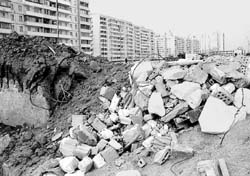Garbage on Our Mind

Not long ago Kyiv hosted a conference dealing with domestic waste disposal. Outwardly this might seem anything but a priority topic, considering global ecological disasters that have unfortunately become Ukraine’s calling card. But all those many dumps in Kyiv, mostly located not far from residential areas, have still piled up a heap of trouble. Newly erected apartment buildings are suddenly invaded by rats, mice, and tenants contract dangerous diseases, not to mention the aesthetic dimension, now that Kyiv is claiming the status of a European capital. In Europe, domestic waste is managed quite simply: there are several colorful containers on every street, each marked by a pictogram: Paper, Plastics, Food, Glass (incidentally, opaque or frosted and clear glass shards are to be dumped in separate containers). To encourage the populace to keep tidy, local authorities work out special programs and stage contests for the best collector of previously used materials, with money prizes. True, their waste disposal laws were developed and improved over decades, while Ukraine’s law is very young and not without some dents of its own.
Our mentality and especially our current economic realities play an important role in dealing with this problem, says Yevheniya Motorina, head of the ecological safety department. Today, the Ukrainian capital’s garbage is delivered to only two dumps, Pyrohovo and Polihon No. 5. Incidentally, the latter’s serviceability has long been questioned and a Health Ministry commission examined the site in March and ordered it closed, because it did not conform to ecological and sanitation standards. Later, it was reopened on condition that sanitary transgressions be corrected “as the work progressed.” The logical question is, of course, where the municipal authorities will find the money to buy disinfecting filters and other expensive equipment. The Kyivspetstrans Corp. handling the problem told The Day that every effort is being made at Polihon No. 5 to bring its facilities closer to European standards. Naturally, the problem would not be all that pressing if we had more garbage-recycling plants. Under the regulations, there should be one such plant per 150,000 residents. There is only one in Kyiv, and its equipment has not been modernized for the eighteen years. As a result, we have 50% of the garbage put aside as “secondary raw materials” instead of the prescribed 5%. Sorting would be helpful, like they do in the West, “on the way,” but this is practically impossible here owing to the existing system of refuse chutes and renovating it is extremely unprofitable under the circumstances. In the end, all that the available dumps and recycling plant cannot accept is left in heaps, close to residential areas and in a nearby forest. Local officials are assigned to solve this problem, and no one will even hazard a comment on how well they are managing. An inspection carried out in April-May to locate unauthorized dumps in the city located 58. They were removed, only to mushroom again soon after. Volodymyr Olshevsky, deputy head of the capital’s ecological resources department, believes the only reason for their reappearance is that the sites were not fenced off. But it appears that efforts are also being made in that direction. A new cleaning system for garbage-sorting stations is going through the red tape of being approved. When in operation, it will help extract solid wastes for reprocessing. Improvements are planned in the existing waste-disposal laws. Still, most experts believe that the urgency of this problem in Ukraine has everything to do with the man in the street who is indifferent about the environment. Of course, one gets used to everything with time, and we are likely to have learned to live close to dumps while asking ourselves time and again where all those new diseases are coming from.






